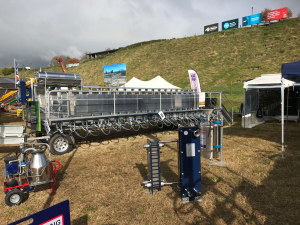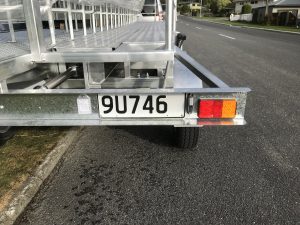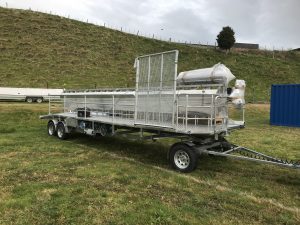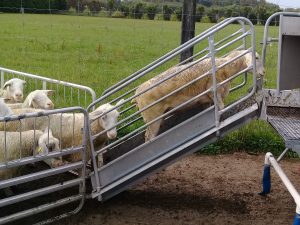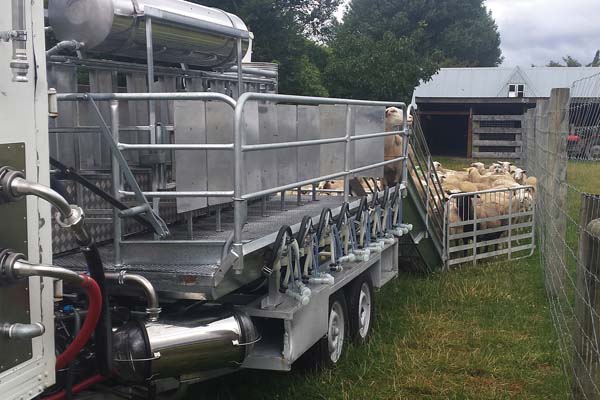Portable milking systems.
Reads engineer, focus on designing and building ergonomic milking systems for the farmer and their livestock. By maintaining regular contact with our clients and industry networks, in turn, ensures our strategic alliance with any transformations that occur within the agricultural sector. By keeping up with market-led research Reads have identified an increased demand for smaller scale milking units specifically designed for sheep, goat, and recently deer.
In collaboration with our client’s concept and Reads design capabilities our latest innovation is a portable 20-bail sheep milking unit. The sleek design encompasses an all component milking unit on a galvanised trailer. This has been the third portable sheep milking unit our clients have had commissioned by Reads, upgrading the unit size each time. Reads first design was an 8-bail unit to test the design and suitability. With successful use of the 8-bail unit, our clients business growth demanded a larger 16-bail portable unit. Subsequently, the 16-bail unit currently milks 300 sheep and its qualified to do so at the level bound by the validation programme.
Reduce the need to invest in traditional bricks and mortar.
Our clients have found that incorporating a stepping stone approach to business has been an efficient and effective way to grow. Furthermore, the price they are currently receiving for sheep milk is reasonable at $15 – $17 a kg for milk solids. Since the review of the sheep milking industry in 2015, the sheep milking industry is grown at a significant rate.
Reads newly designed portable 20-bail milking unit was at the show for public viewing, at the 50th annual Mystery Creek field days 2018. The innovative product has been well received with worldwide interest.
Smaller scale milking systems are used as a stepping stone to enter a new market. For those opposed to investing in the standard farming model of bricks and mortar dairy. The portable unit reduces the risk of investment by owning an asset that is resalable.
Work smarter, not harder.
Further advantages of a portable unit are that it can harvest milk from sites within one farm. So long as the farm is registered with the Ministry of Primary Industries to use the portable milking plant. Consequently, the trailer is registered for road transportation.
The portable unit is designed to be towed behind the bulk milk tank on a truck. With the portable trailer housing its own generator, cooler unit and CIP recycled hot water washing system. The trailer unit encompasses everything you would find in a standard milking shed. The component layout of the system is based on the ergonomics and optimal systems layout to minimise waste. The ergonomics of the system are required to milk the sheep efficiently with minimal discomfort for the operator.
Compact thoughtful design.
The milking unit itself has sorting gates and railings to orient the sheep on the platform while milking. Materials are food grade, with non-slip footing. Entry and exit are achieved by fold down access ramps, strategically placed. Clients have found that sheep are easy to train to run on and off and adds they very rarely urinate or defecate while they are on the trailer. Cleaning the system after milking works well and has proven to be well designed. The effluent is collected in a tank under the trailer and can be mixed with the washing water – about 120 litres – and sprayed out on to a paddock. The effluent of the system is managed using a perforated sheet, which the sheep stands on, over a collection tray. The collection tray is sloped to a recessed collection point with a drain port that empties into the effluent tank for disposal. We are advised the quantity collected is minimal.
The teat cups, although similar to those found in a cow dairy shed, pulsate at a much faster rate and emulate the drinking pattern of lambs. The clusters are specifically designed for sheep and have an automatic shutoff valve that automatically shuts off the cluster vacuum when not in use. As the cluster automatically shuts off the amount of air that is admitted into the milk line is reduced. Therefore, reducing instances of slug flow within the milk line, foreign matter entering the cluster, and cluster drop-off of nearby stalls caused by insufficient vacuum pressure caused by the air admission.
Bring the plant to the livestock.
The portable milking unit even provides a feed system as additional nutritional support for the animal, as well as providing an incentive to let down. The sheep are enticed on to the trailer by a small amount of feed and a quick-release exit system frees them rapidly while keeping the flow through the milking stand going.
Furthermore, the portable milking trailer increases the accessibility of the milking plant to the stock, compared to traditional milking sheds reducing the time for the stock to travel to and from the milking platform. An additional advantage is the portable milking platform can transport the milk temporarily in the rear of the vehicle in a cooling storage vat.
The 20-bail unit is the first prototype Reads have built at this size, and it may need the odd minor tweak, however, so far, it’s proving to be a great success. Read milking systems can be modified to suit the individual needs for milking and diverse types of livestock in turn providing our customers with ergonomic systems.

